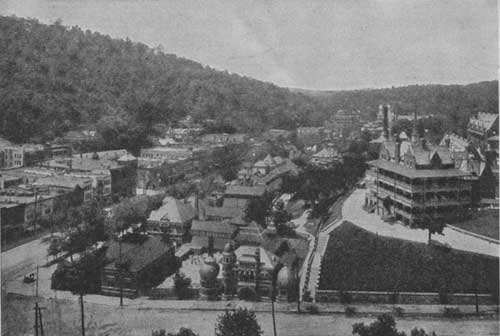|
NATIONAL PARK SERVICE
Glimpses of our National Parks |

|
XV
THE HOT SPRINGS RESERVATION
Special Characteristic: Curative Hot Springs Possessing Radio-Active Properties
AS different, almost, as possible from the great scenic national parks which we have been considering, but in its own particular way as extraordinary as any of them, the Hot Springs Reservation in the Ozark Mountains of Arkansas must be accorded a distinguished place among American resorts of national character and ownership. The reservation is the oldest national park, having received that status in 1832, 40 years before the wonders of the Yellowstone first inspired Congress with the idea that scenery was a national asset deserving of preservation for the use and enjoyment of succeeding generations.

|
| HOT SPRINGS RESERVATION, SHOWING BATH HOUSE ROW AND THE ARMY AND NAVY GENERAL HOSPITAL |
No esthetic consideration was involved in this early act of national conservation. Congress was inspired only by the undoubted, but at that time inexplicable, power of these waters to alleviate certain bodily ills. The motive was to retain these unique waters in public possession in order that they should be available to all persons for all time at a minimum, even a nominal, cost.
The low, irregular mountain masses known as the Ozarks cover the greater part of southern Missouri and overlap northern Arkansas, where, in marked contrast with the surrounding plains, they become higher, more rugged, and heavily timbered.
The country is one of much beauty. Hot Springs Mountain, from whose sides flow the cleansing waters, is about 50 miles west by south from Little Rock. Here, as early as 1804, began the settlement which has developed into the handsome prosperous city of 16,000 inhabitants known as Hot Springs. It is a resort city, made wealthy from the many thousands of visitors seeking health from the adjacent Government springs and pleasure in the high and beautiful neighborhood country with its excellent drives and woodland paths, its mountain and river views, its social gayeties, and its exceptional golf.
Adjoining the borders of the city at the mountain's foot lies the reservation, a tract of 912 acres inclosing all the 46 hot springs. Eleven bathhouses are in the reservation and a dozen more in the city, all under Government regulation. There are also cold-water springs of curative value. In the city are many hotels and boarding houses with rates ranging from lowest to highest. The Department of the Interior has spent altogether more than a million dollars on the development of the reservation. The reservation contains, also, an Army and Navy hospital.
Dr. William P. Parks, superintendent of the reservation, states in his annual report for 1915 that while the baths are constantly given for such ailments as seem to be benefited in the experience of physicians who have prescribed their use and carefully observed the results, there are still many physicians throughout the country who, never having themselves tested the springs, hesitate to send patients there.
"No physician who is thorough and looks for the best results from the medicines he gives," says Dr. Parks, "would think of prescribing a drug whose physiological effects and therapeutic value had not been scientifically proven and described."
A perfect explanation, this, of a natural scientific conservatism.
The War Department's years of experience in the Army and Navy Hospital, however, is thoroughly convincing, and the medical staff officially affirm the waters marked curative value for rheumatic and many grave ailments more or less kindred.
Recently the National Park Service has established on the reservation the Oertel system of graduated exercise which has proved so successful at the celebrated springs of Bad Nauheim, Germany. Courses have been laid out on the mountain slopes with distances scientifically established and plainly marked by monuments. The length and character of the walks are determined by physicians according to the condition and progress of the patient.
INTERESTING INDIAN TRADITIONS
Tradition has it that the curative properties of the hot springs were known to the Indians long before the Spanish invasion. It is probable that they were known to De Soto, who died in 1542 less than a hundred miles away. It is tradition that Indian tribes warred for their possession but that finally a truce was made which enabled all tribes to avail alike of their waters.
Government analyses of the waters disclose more than 20 chemical constituents, but it is not these nor their combination to which is principally attributed the water's unquestioned virtue in many diseased conditions, but to their remarkable radioactivity. The National Park Service will send full information to inquirers.
| <<< Previous | <<< Contents>>> | Next >>> |
yard4/chap15.htm
Last Updated: 30-Oct-2009